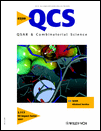QSAR for Inhibition of Pseudomonas Species Lipase by 1-Acyloxy-3-N-n-octylcarbamyl-benzenes
Abstract
1-Acyloxy-3-N-n-octylcarbamyl-benzenes (1–9) are synthesized to characterize the Quantitative Structure–Activity Relationship (QSAR) for the Third Acyl Group Binding Site (TACS) of Pseudomonas species lipase. Inhibitors 1–9 are characterized as pseudo or alternate substrate inhibitors of the enzyme. The inhibition constant (Ki) and carbamylation constant (k2) for the enzyme inhibitions by inhibitors 1–9 are determined. The carbamate carbons of the n-octylcarbamyl moieties of inhibitors 1–9 are nucleophilically attacked by the active site serine of the enzyme and the n-octylcarbamyl groups of inhibitors 1–9 are bound to the Acyl Group Binding Site (ACS) of the enzyme. Both pKi and log k2 values are linearly corrected with the Hansch hydrophobicity π values of the substituents of the acyl moieties of inhibitors 1–7. The slopes for these corrections are 0.13 and 0.02, respectively. This result suggests that the enzyme inhibitions by inhibitors 1–7 have a common mechanism. Thus, all acyl moieties of inhibitors 1–7 should bind to the TACS of the enzyme since the acyl and carbamyl moieties of inhibitors 1–7 are meta to each other. This result also indicates that the major interaction between the acyl moiety of inhibitors 1–7 and the TACS of the enzyme is primarily the hydrophobic interaction. The more hydrophobic characters of inhibitors 1–7 are, the more tightly these inhibitors bind to the enzyme. In contrast, 1-triphenylacetoxy-3-N-n-octylcarbamyl-benzene (8) and 1-trimethylacetoxy-3-N-n-octylcarbamyl-benzene (9) do not bind to the TACS of the enzyme due to the fact that the inhibitions by both inhibitors are not linearly correlated with π. It is possible that these two inhibitors are too bulky to fit into the TACS of the enzyme.




